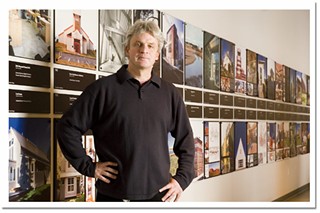Unlike doctors and nurses, lawyers or teachers, architects don’t often speak up about the work they do. While the media often makes “starchitects” of a handful in the profession, the majority of architects labour in silence and under the watch of an often vocally disapproving, fretful public. There are those who appreciate new and unconventional designs, but they often keep quiet, or only speak up in defence of a new project or proposal.
Some architects like the silence. Others would gladly break it.
Count the organizers of the events and retrospective exhibition celebrating the 75th anniversary of the Nova Scotia Association of Architects among the latter group wishing to start a conversation about architecture in this region, Halifax in particular.
“Our interest was to try to talk about the community of architects working here,”explains Steven Mannell at his office in Dalhousie’s School of Architecture.
Mannell helped organize the exhibition at Pier 21 that brings together illustrated histories of award-winning buildings—from 20 years of the Lieutenant Governor’s Design Awards for Architecture—with models of Dalhousie student work, working drawings of current projects (including Citadel High) and various ephemera, notably an evolutionary timeline of architecture in this province.
Looking at the long wall of mounted photographs and digital renderings, you see how local architects grow into their specialties. You see how styles, purposes and sites vary. You see how architecture pervades our lives.
Still, debate can dominate the conversation. For example, over the proposed United Gulf Towers—the so-called “twisted sisters”—by Toronto architect Siyamek Hariri.
“I think architects were, like any group in the city, mixed in their opinions,” Mannell says. He agrees that for some, the twisted towers underscored the stereotypical view of the ego-driven, self-righteous architect driven to impose his or her will on the community.
“The idea of architects more strongly advocating for the role of architecture in society is something that’s only been floating around in the profession for probably 15 or 20 years,” says Mannell. “Architects sometimes feel there’s this sort of conflict: We get paid to do this work so maybe we shouldn’t be speaking out about it. Maybe it’s a lack of a clear model on how to do that.”
Historically, there have been moments when architects spoke their minds. Locally, there was the proposed “waterfront expressway. Architects said this vision of the city is wrong, a bad idea.” There were calls to preserve the waterfront and renovate Historic Properties, Mannell points out.
History may shift very soon, he adds. “It’s at an interesting moment in the profession here. A lot of the principals are getting to that time in their career when they’re thinking about retirement—handing it over to the next generation.”
An intern architect, Heather Bown is working toward her full licence. Besides working as vice-president of project management at an established Halifax firm, she volunteered, along with several other young designers, on the month-long campaign to mark the NSAA’s 75 years.
Bown agrees the public perception of architecture is often “low,” the profession often described as “insular,” but says that can change. Architects already have the skills.
“In architecture communication is everything,” Bown says; architects already collaborate with clients, other members of the firm’s design team and with other professionals from engineering and construction.
Other lines of communication opening for the NSAA anniversary are public talks. Author Thomas Homer-Dixon is speaking next Thursday, and talks earlier in the month, by the likes of architect Raymond Moriyama, drew an audience of roughly 200 people, Mannell says. During one of the workshops the NSAA organized, high school students learned how Citadel High came together. “Certainly Citadel High has been a prominent project in peoples’ imaginations because it’s right there on Bell Road at the base of the Citadel,” Mannell says. “It’s on the way to everywhere.”
Thomas Homer-Dixon, author of The Upside of Down: Catastrophe, Creativity and the Renewal of Civilization, speaks May 31 at Heritage Hall in Pier 21, 1055 Marginal, 7pm, free, www.nsaa.ns.ca The exhibit Celebrating Nova Scotia Architecture runs through May 31.













